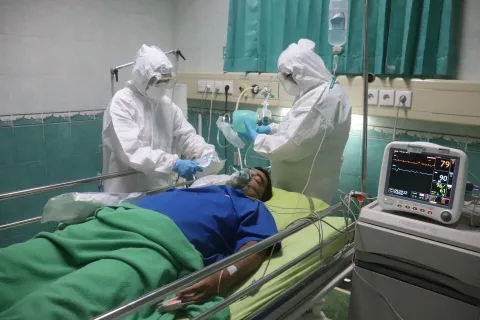How to build better health care technology
UBC researchers share lessons learned from innovative origami-inspired ventilator project

One of the many challenges faced by hospitals during the COVID-19 pandemic has been a shortage of ventilators. Health care facilities in low- and middle-income countries have struggled especially hard to procure the life-saving machines, which can cost tens of thousands of dollars each.
Last year, an interdisciplinary team led by UBC Nursing professor and Canada Research Chair in Senior Care Dr. Lillian Hung set out to help make ventilators more accessible. What they created is an effective, affordable ventilation device that costs only $100 to produce and weighs in at just six kilograms — ideal for use in remote care settings and patient transports like ambulances.
The patent-pending technology can be made using a 3D printer, cutting production costs dramatically. It may also last longer than traditional ventilators do, thanks to an innovative origami pattern-inspired airbag design that minimizes wear-and-tear from repeated compressions.
In a recent issue of Health and Technology, the team — made up of nurses, engineers, doctors and others — described what they learned from their product development experience. We spoke with lead author and project coordinator Margaret Lin, a registered nurse and research assistant in Dr. Hung's Innovation in Dementia and Aging (IDEA) Lab, about their work.
Why did you decide to write about your ventilator project experience?
Little is known about how frontline health care professionals and engineers can collaborate to develop better health care technology. By sharing the tips and lessons we learned during the course of our project, we wanted to show how critical it is to collaborate with colleagues from various disciplines — and especially frontline clinicians — during the product development process.
How did you connect the clinicians and engineers who worked on your project?
Our clinical collaborator, Ingrid Hakanson — a respiratory therapist at Vancouver General Hospital — helped recruit frontline clinicians to attend focus groups for our project. In these groups, the clinicians watched Dr. Woo Soo Kim and Tae-Ho Kim from the Additive Manufacturing Laboratory at Simon Fraser University demonstrate their prototype design of the 3D-printed ventilator.
Then Dr. Hung and I asked the participating frontline health care professionals — including nurses, respiratory therapists and physicians working in intensive care or urgent care settings at Vancouver General Hospital — a few questions. We asked them:
- What has the experience been like when caring for ventilated patients during the COVID-19 pandemic using existing ventilators?
- What is your opinion about the new portable ventilator prototype design?
- What can be done to improve this ventilator design?
After the focus group, the engineering team integrated the feedback into the development of the ventilator.
What did you find?
Through the focus group discussions, we came up with five practical tips for the successful co-development of health care technology. By "successful", I basically mean technology that is well-adapted to the environment where it's used and that meets the needs of both patients and clinicians.
These tips can be represented by the acronym AGILE:
Analyse users' needs first: We were able to avoid unfavourable outcomes by first discussing ventilator safety standards and concepts, among other things, with clinicians.
Gain insights into the complex context of health care: The diverse group of professionals we spoke to provided us with valuable insights into things like patient populations, infection control requirements and hospital operation processes.
Involve users early and frequently: By soliciting clinicians' feedback early and throughout the development process, we likely saved money, time and effort and created a more effective and user-friendly ventilator.
Lead with a prototype: Having a prototype helped the clinicians visualize the product and brainstorm solutions. They provided invaluable suggestions about size, compression speed, material, structure and other aspects of the product. (Creating the prototype with them would have been even better.)
Educate and support: To maximize the effectiveness of the tips above, academic institutions and health care organizations need to support the teaching and practice of multidisciplinary collaboration, empathic design and other ways of connecting product developers and end-users.
What sets your work apart from that of other groups?
We brought together frontline clinicians, engineers, industry partners and nurse researchers to co-design health care technology for patient care. Our transdisciplinary partnership sets our work apart from traditional health technology designs, and we hope it inspires more meaningful involvement of health care clinicians in the design of health technologies.
Photo by Mufid Majnun on Unsplash


